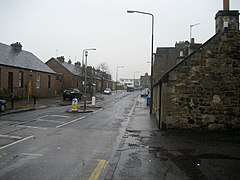Winchburgh
| Winchburgh | ||
|---|---|---|
| Main street of Winchburgh | ||
| Coordinates | 55 ° 57 ′ N , 3 ° 28 ′ W | |
|
|
||
| Residents | 2490 2011 census | |
| administration | ||
| Post town | BROXBURN | |
| ZIP code section | EH52 | |
| prefix | 01506 | |
| Part of the country | Scotland | |
| Council area | West Lothian | |
| British Parliament | Livingston | |
| Scottish Parliament | Linlithgow | |
Winchburgh (Old English Wincelburh , "town in the corner (of the brook)") is a town in the northeast of the Scottish Council Area West Lothian or in the traditional county of Linlithgowshire . It is located about six kilometers northeast of Livingston and 16 kilometers west of central Edinburgh on the Niddry Burn .
history
Presumably it was John Seton, 2nd Lord Seton , who had Niddry Castle built in the 15th century . At that time, the Tower House was one of the most important fortifications in the region and provided shelter for Queen Mary Queen of Scots after her flight from Loch Leven Castle in 1568. With Duntarvie Castle , James Durham built the second fortification in the area in 1588. Around 1900, the Oakbank Oil Company built a plant in Winchburgh. The spoil heaps of the extracted oil shale are still visible in the landscape today. In 1960 it was the last oil shale processing plant in Scotland.
Since 1961, the population of Winchburgh has fluctuated only slightly between around 2400 and 2600. In the course of the 2011 census survey, 2490 people were counted in Winchburgh.
traffic
Winchburgh is conveniently located in the Edinburgh area. With the M8 , the M9 and the M90, three motorways can be reached within a radius of five kilometers . Furthermore, the A89 ( Glasgow - Newbridge ), the A899 (Livingston - Broxburn ) and the A904 ( Falkirk - South Queensferry ) run in the same radius around Winchburgh.
In the 19th century Winchburgh received its own station on the North British Railway . The infrastructural connection between Edinburgh and Glasgow is still in operation today. The Winchburgh train station has since been closed. Most of the railway line runs through a tunnel under the village. South-east it crosses to the imposing Almond Valley Viaduct the Almond . In 1862 the Winchburgh railway accident occurred , in which two trains collided head-on.
The opening of the Union Canal in 1822 was important for the growth of Winchburgh. The canal runs directly through the village. The Edinburgh Airport is located six kilometers to the east.
Individual evidence
- ^ Winchburgh Public Art Plan . Winchburgh Community Council. 2016.
- ↑ a b c d Entry in the Gazetteer for Scotland
- ↑ Listed Building - Entry . In: Historic Scotland .
- ↑ Entry on Niddry Castle in Canmore, the database of Historic Environment Scotland (English)
- ↑ Scheduled Monument - Entry . In: Historic Scotland .
- ^ Information in the Gazetteer for Scotland
- ↑ 2011 census data
- ↑ Winchburgh in: FH Groome (ed.): Ordnance Gazetteer of Scotland: A Survey of Scottish Topography, Statistical, Biographical and Historical , Grange Publishing Works, Edinburgh, 1882-1885.
- ↑ Information on Winchburgh Train Station

